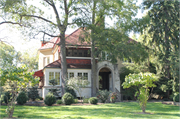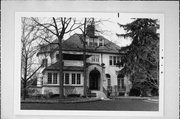| Additional Information: | Adolph Meinecke was born in Burhave, Germany in 1830 and immigrated to the United States in 1848. After working in an importer’s office in New York City for seven years he moved to Milwaukee and married Mary Louise Krafft. The couple had two sons. Meinecke established the Milwaukee Willow Works, a successful manufacturer of toys and furniture, in 1855. The company developed a factory and a 40-acre field of willows on the north side of Milwaukee and produced wicker furniture, baby carriages, and handbags and later expanded to manufacturer popular toys of the era including hobby horses, croquet sets, and wooden Indian clubs. The successful firm made the Meinecke family wealthy and Adolph was appointed as one of the Wisconsin Commissioners to the Centennial Exposition at Philadelphia in 1876. He was also the vice-president of the Wisconsin Humane Society and the Milwaukee National Bank.
In 1893, Meinecke retired from the presidency of Milwaukee Willow Works and newly formed Meinecke Toy Company and turned over operations of the companies to his sons, Ferdinand and Adolph, Jr. His wife Mary died in 1894. Meinecke constructed a summer home in the rural setting of the Town of Wauwatosa in 1895 at the present intersection of W. Meinecke Avenue and N. 100th Street. After his retirement, Adolph contributed a series of literary articles to German editions of American magazines and wrote a history of his native Oldenburg in Germany. Adolph Meinecke died in 1905. In his will, Meinecke bequeathed his land in Milwaukee to the city; in exchange, the city renamed a nearby street Meinecke Avenue, which runs east-west through Milwaukee and Wauwatosa.
The Meinecke House, originally a large clapboard sided Gothic Revival design, was purchased by Fred Mayer and his family in 1922 and extensively remodeled. The architect Eugene R. Liebert designed the renovations, and the house was transformed into a vaguely Mediterranean Revival style home with stucco and lannon stone exterior. The house was purchased and extensively renovated again in 1987. Other resources associated with Meinecke, including the Meinecke Mansion, formerly located at 1203 N. Milwaukee Avenue, and the Milwaukee Willow Works, formerly located at the intersection of North 19th Street and North Avenue in Milwaukee, are both non-extant.
Eugene Liebert was born in Germany in 1866 and immigrated to the United States settling in Milwaukee in 1883. He began his first position as a draftsman the following year. After working as a draftsman and construction foreman for several years he went into a partnership with H. P. Schnetzky in 1891 as an architect. The pair successfully designed several notable buildings in Milwaukee from the period including the Germania Building and J. P. Kissinger Block. Liebert established his own office in 1897. A few of his commissions included the Red Stat Yeast Plant, the A. O. Trostel House, and two homes for Henry Harnischfeger. He purposefully catered to the large German American population and cultivated work that reflected popular German stylistic influences. During the twentieth century, two of his four sons, Walter F., and Carl, slowly took over the operation of the Liebert architectural business. Liebert designed the revivalist renovations to the Adolph Meinecke summer home, located at 2517 N. 100th Street in Wauwatosa, for Fred Mayer in 1922. Eugene Liebert died in 1945. |
|---|


